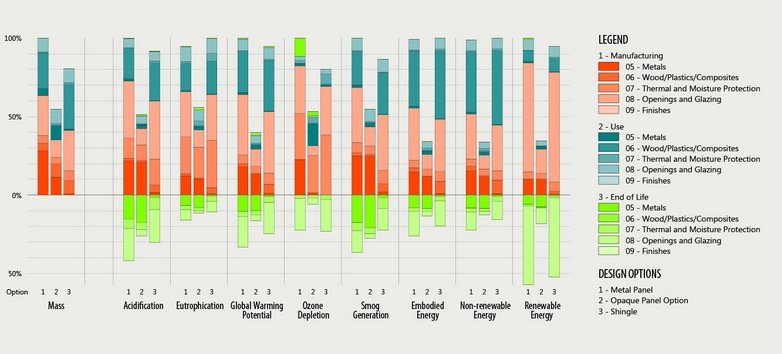Kieran Timberlake and PE International have developed Tally, a new analysis tool to help BIM users keep better score of their projects’ complete environmental footprints. When used alongside other critical studies like daylighting simulation and energy modeling, BIM tools like Tally can help construction professionals move towards data-driven analysis for whole building life cycle assessment, writes TriplePundit.com.
Kieran Timberlake explains Tally:
Quantifying environmental impact typically involves performing a Life Cycle Assessment, which is a relatively new and confounding practice for most architects. Currently, no efficient means exists to evaluate environmental impact of materials during the design and planning process, when it can have the most influence on design decisions and building performance. An architect needs this impact data at the time of material specification, but the laborious process required for calculating embodied environmental impact across a broad range of design decisions prevents this from happening at crucial moments in the design process.
In principle, Building Information Modeling (BIM) ought to enable architects to acquire this information, but in practice, projects are not modeled to a sufficient level of detail to account for all of the materials in a building at their actual volume. In order to address these challenges, we invented Tally™, a Revit app that allows users to imbue each assembly with information about the architectural products it contains. Tally™ quantifies embodied energy along with other environmental impacts and emissions to land, air, and water. It can be used for whole-building analysis or for comparative analyses of various design options, and it can account for the diverse range of material classes defined in a BIM model, as well as materials that are not modeled explicitly.
For more on Tally, visit: http://kierantimberlake.com/pages/view/95/tally/parent:4.
Related Stories
| Nov 10, 2011
Skanska Moss to expand and renovate Greenville-Spartanburg International Airport
The multi-phase terminal improvement program consists of an overall expansion to the airport’s footprint and major renovations to the existing airport terminal.
| Nov 10, 2011
Suffolk Construction awarded MBTA transit facility and streetscape project
The 21,000-sf project will feature construction of a cable-stayed pedestrian bridge over Ocean Avenue, an elevated plaza deck above Wonderland MBTA Station, a central plaza, and an at-grade pedestrian crossing over Revere Beach Boulevard
| Nov 10, 2011
Thornton Tomasetti’s Joseph and Choi to co-chair the Council on Tall Buildings and Urban Habitat’s Outrigger Design Working Group
Design guide will describe in detail the application of outriggers within the lateral load resisting systems of tall buildings, effects on building behavior and recommendations for design.
| Nov 9, 2011
Lincoln Center Pavilion wins national architecture and engineering award
The project team members include owner Lincoln Center for the Performing Arts, New York; design architect and interior designer of the restaurant, Diller Scofidio + Renfro, New York; executive architect, FXFOWLE, New York; and architect and interior designer of the film center, Rockwell Group, New York; structural engineer Arup (AISC Member), New York; and general contractor Turner Construction Company (AISC Member), New York.
| Nov 9, 2011
Sika Sarnafil Roof Recycling Program recognized by Society of Plastics Engineers
Program leads the industry in recovering and recycling roofing membrane into new roofing products.
| Nov 9, 2011
American Standard Brands joins the Hospitality Sustainable Purchasing Consortium
American Standard will collaborate with other organizations to build an industry-wide sustainability performance index.
| Nov 8, 2011
Transforming a landmark coastal resort
Originally built in 1973, the building had received several alterations over the years but the progressive deterioration caused by the harsh salt water environment had never been addressed.
| Nov 8, 2011
WEB EXCLUSIVE: Moisture-related failures in agglomerated floor tiles
Agglomerated tiles offer an appealing appearance similar to natural stone at a lower cost. To achieve successful installations, manufacturers should provide design data for moisture-related dimensional changes, specifiers should require in-situ moisture testing similar to those used for other flooring materials, and the industry should develop standards for fabrication and installation of agglomerated tiles.















